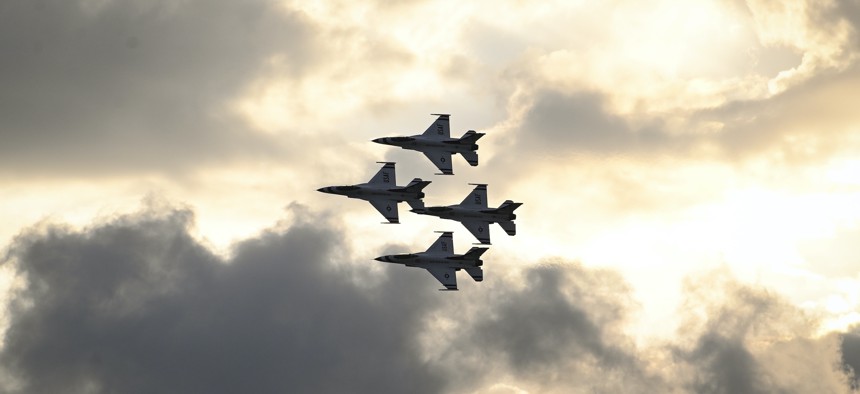
The U.S. Air Force Air Demonstration Squadron "Thunderbirds" fly over Shaw Air Force Base, South Carolina, March 31, 2022. U.S. Air Force / Senior Airman Madeline Herzog
The Air & Space Brief: Space Symposium faces post-Russian invasion reality; Airlifters get fuel tweaks; Boeing’s big win
Welcome to the Defense One Air and Space newsletter. Here are our top stories this week:
Space Symposium: Thousands of space professionals from around the world are in Colorado Springs this week for Space Symposium, where talk of Russia’s invasion of Ukraine—and the immediate implications on military and civilian space activity—is ubiquitous, and Russia’s Roscosmos is noticeably absent. Also, the unprecedented role of commercial space in generating real-time war imagery, such as Maxar’s Monday release of possible war crimes in Bucha, Ukraine, and the more urgent implications for NASA’s ISS support are already dominating the conversation here. Defense One correspondents Tara Copp and Jacqueline Feldscher are there, and have more here.
Guardians get real-time space defense training: Space Force awarded Slingshot Aerospace a $25-million, 39-month contract to provide a digital twin of orbital space. The system will autonomously comb through public and commercial data to provide Guardians a picture of the state of space as it is at any minute, including the locations of more than 7,000 orbiting satellites, plus space debris, the potential for solar flares or other space weather, and the chance of disruptions to radio communications.
Boeing’s big win: Hammered by several years of losses within its commercial plane-making business, Boeing now stands to gain billions of dollars in defense work if Congress green-lights the Biden administration’s 2023 budget request. And comments made by senior defense officials hint that even more business could be on the way.
Airlifters get fuel tweaks: The 2023 budget request includes $42.5 million to install drag-reducing devices on C-130s, C-135s, and C-17As to reduce their appetite for fuel and another $31.5 million to modify KC-135 and C-17 engines to reduce the amount of fuel they consume; $55 million will fund the development of a full-scale blended wing body aircraft designed to be significantly more fuel efficient than traditional airframes.
Sign up to get The Air & Space Brief every Tuesday from Tara Copp, Defense One’s Senior Pentagon Reporter. On April 5, 2002, the European Space Agency announced that there may be as many as 1.9 million asteroids larger than one kilometer in diameter in our solar system, “about twice as many as previously believed.”
 From Defense One
From Defense One
Space Force Buys a Digital Twin of Orbital Space // Jacqueline Feldscher
Updated "minute-by-minute," the Slingshot Aerospace tool is expected to improve training and real-world planning.
Boeing Poised to Score Billions in Biden's Pentagon Budget Request // Marcus Weisgerber
Meanwhile, Lockheed stands to lose. But don't count Congress out.
New Budget Would Modify Planes, Pursue Hybrid Vehicles To Tackle Climate Change // Jacqueline Feldscher
The Pentagon's 2023 proposal aims to reduce C-130 drag, modify KC-135 engines, and design a fuel-sipping airframe.





